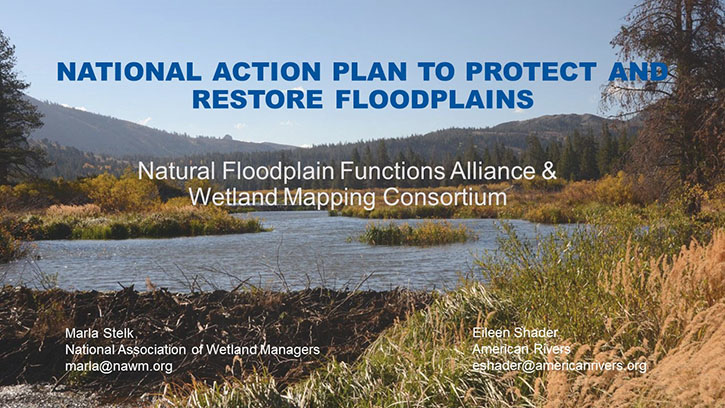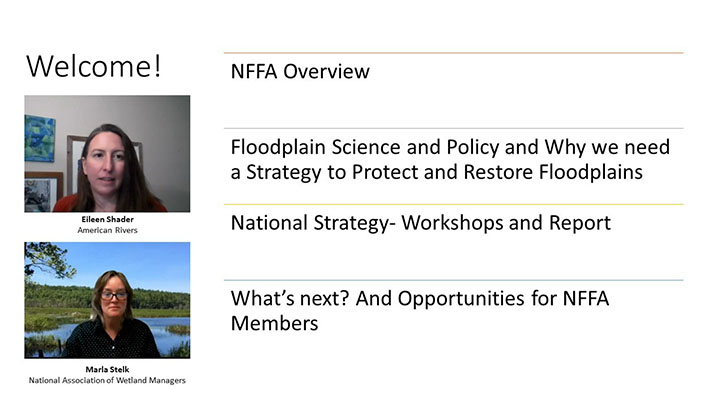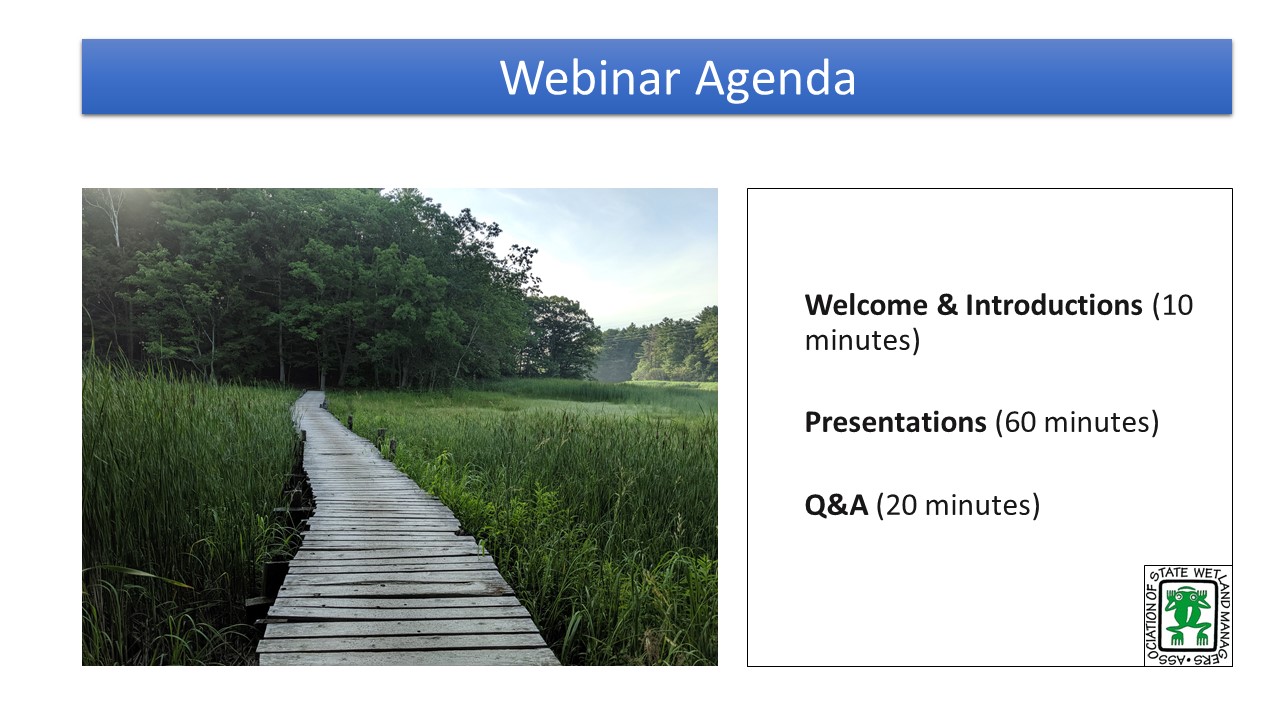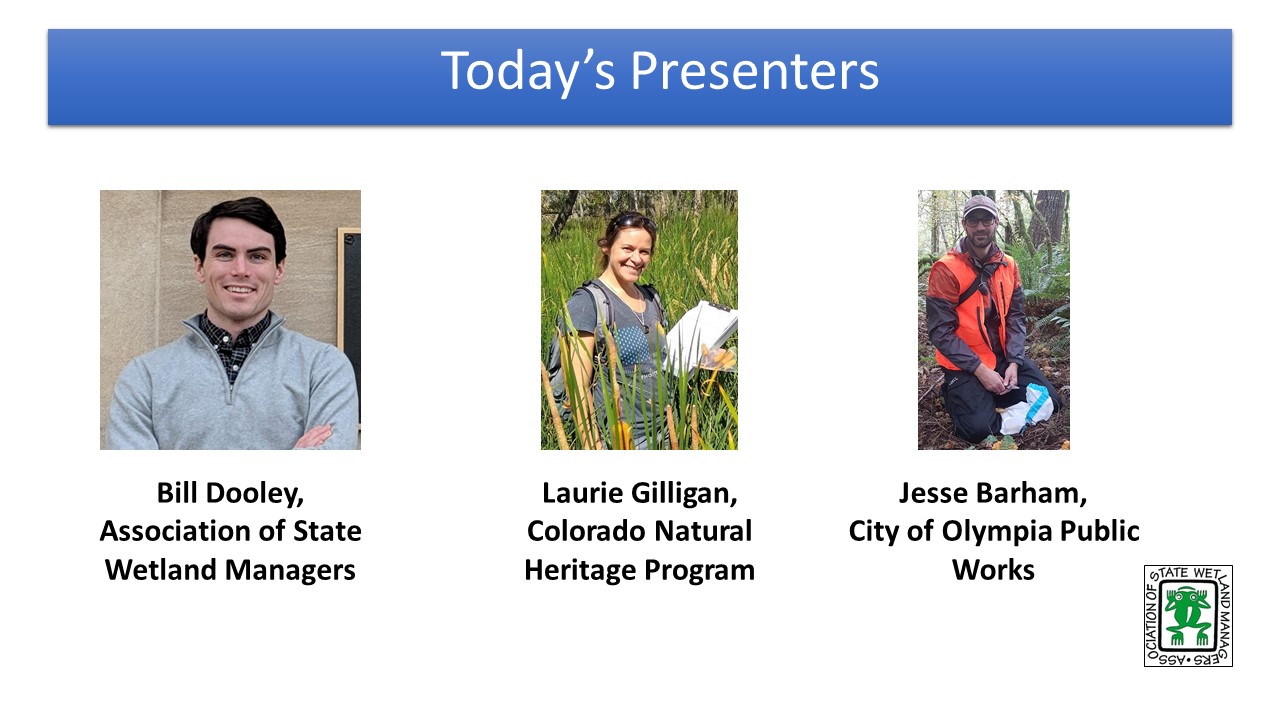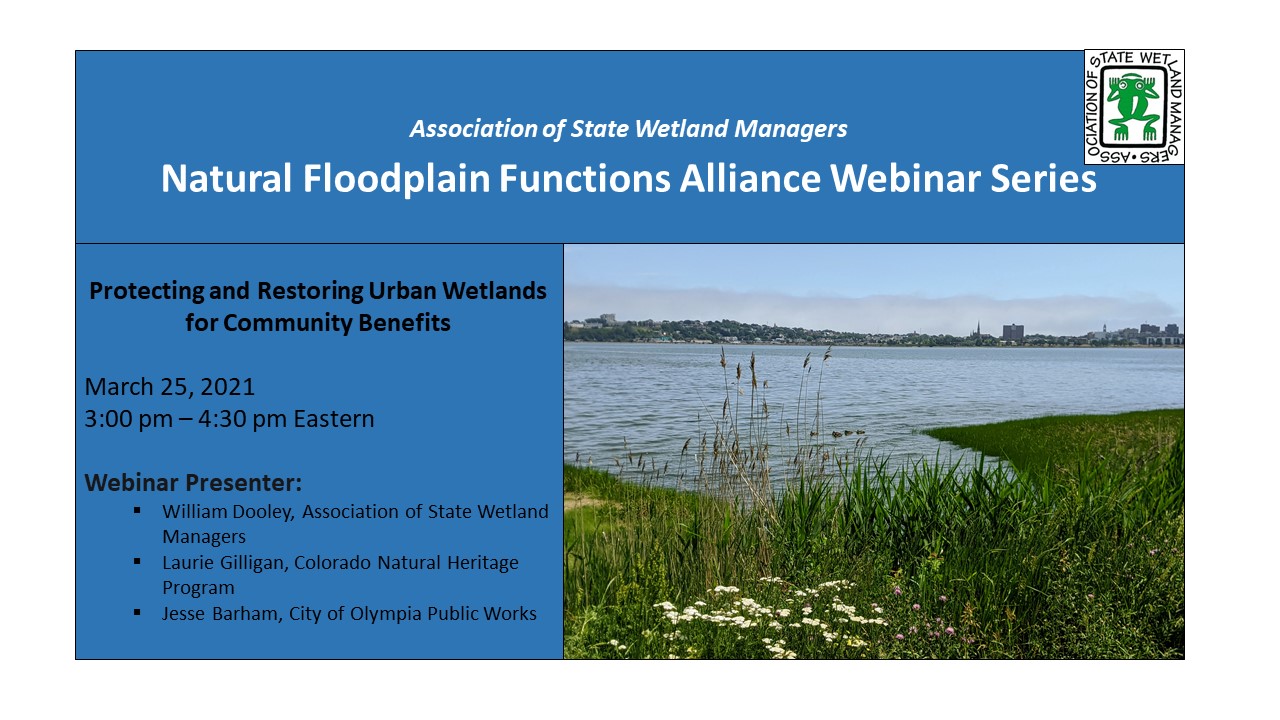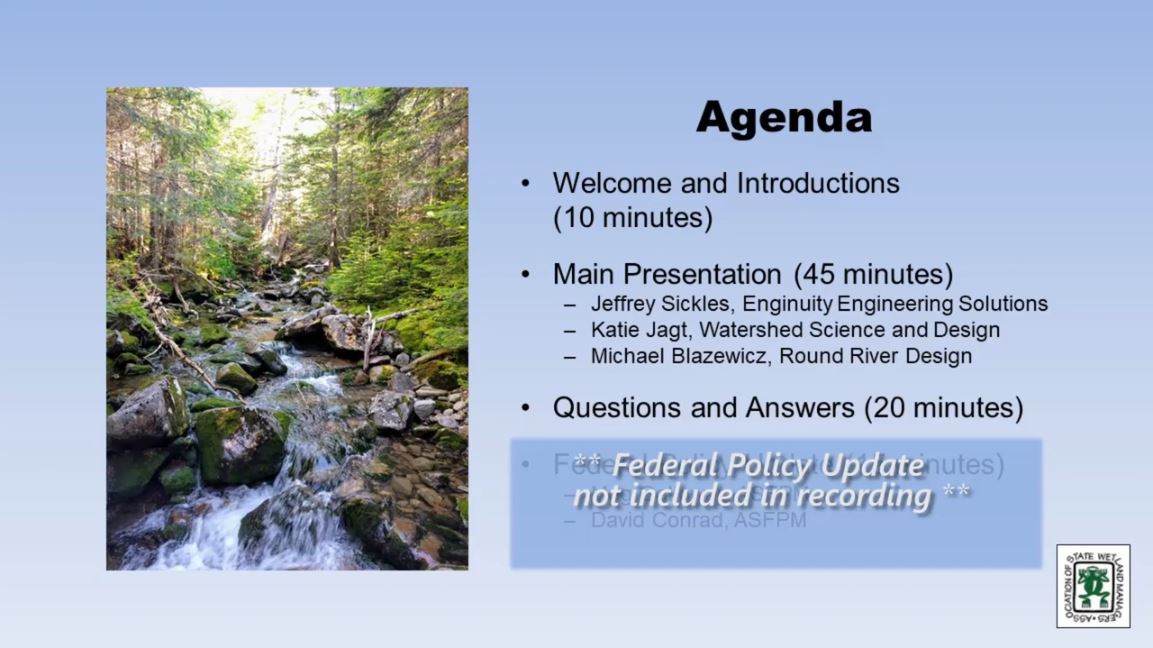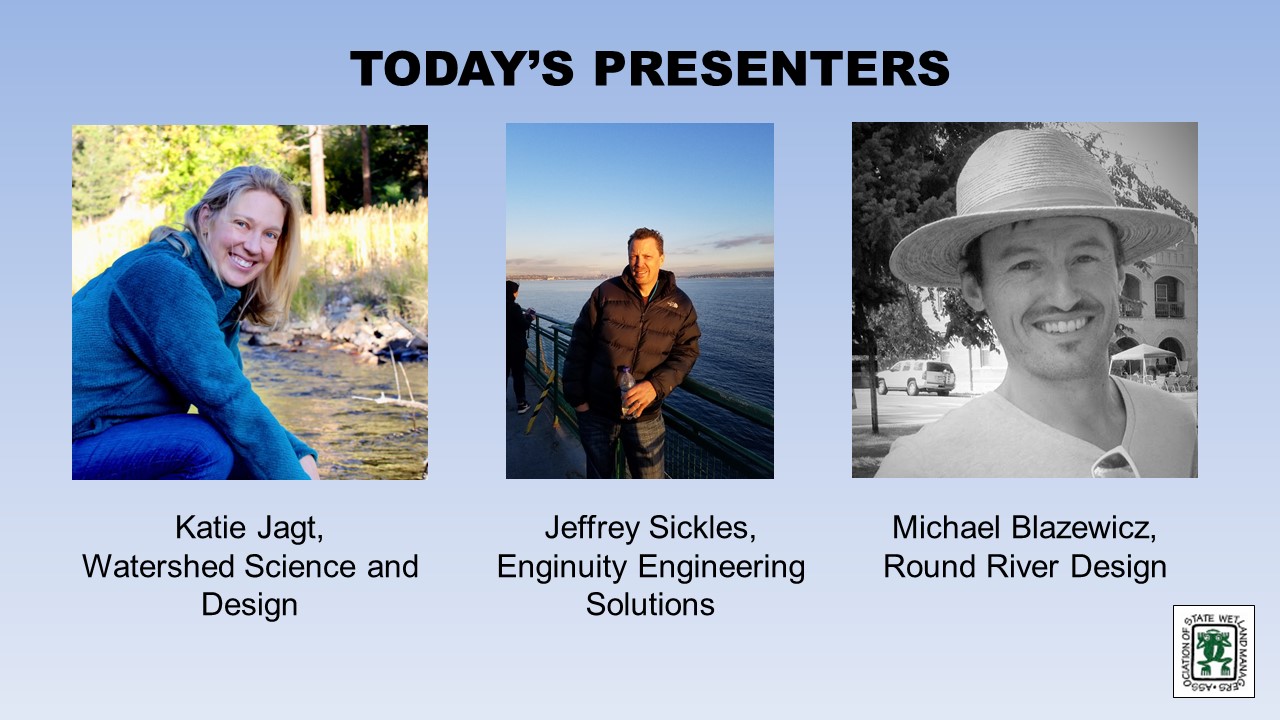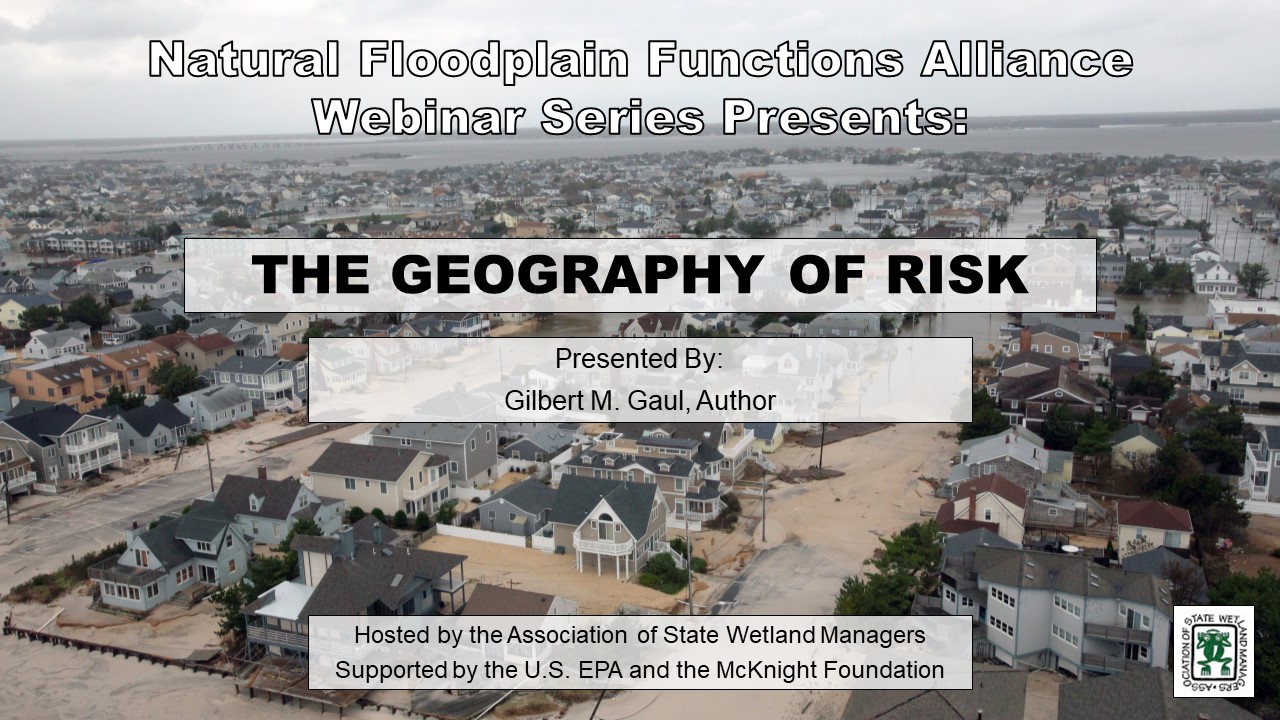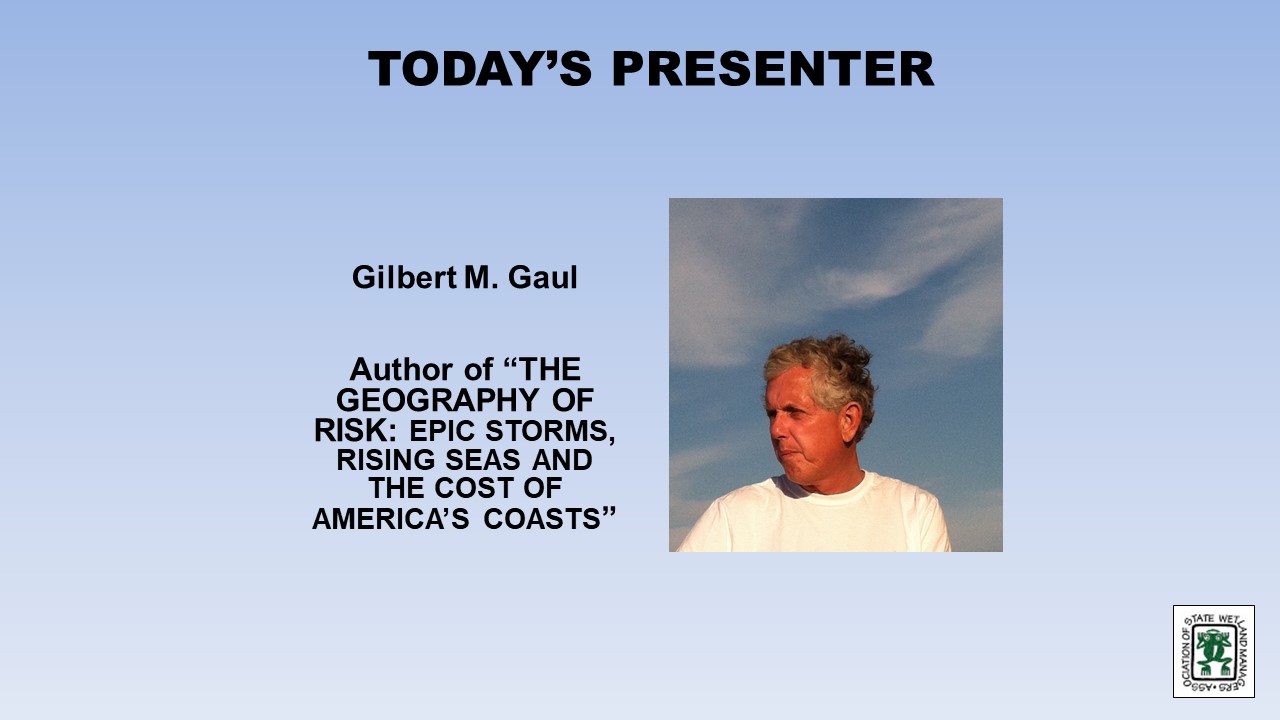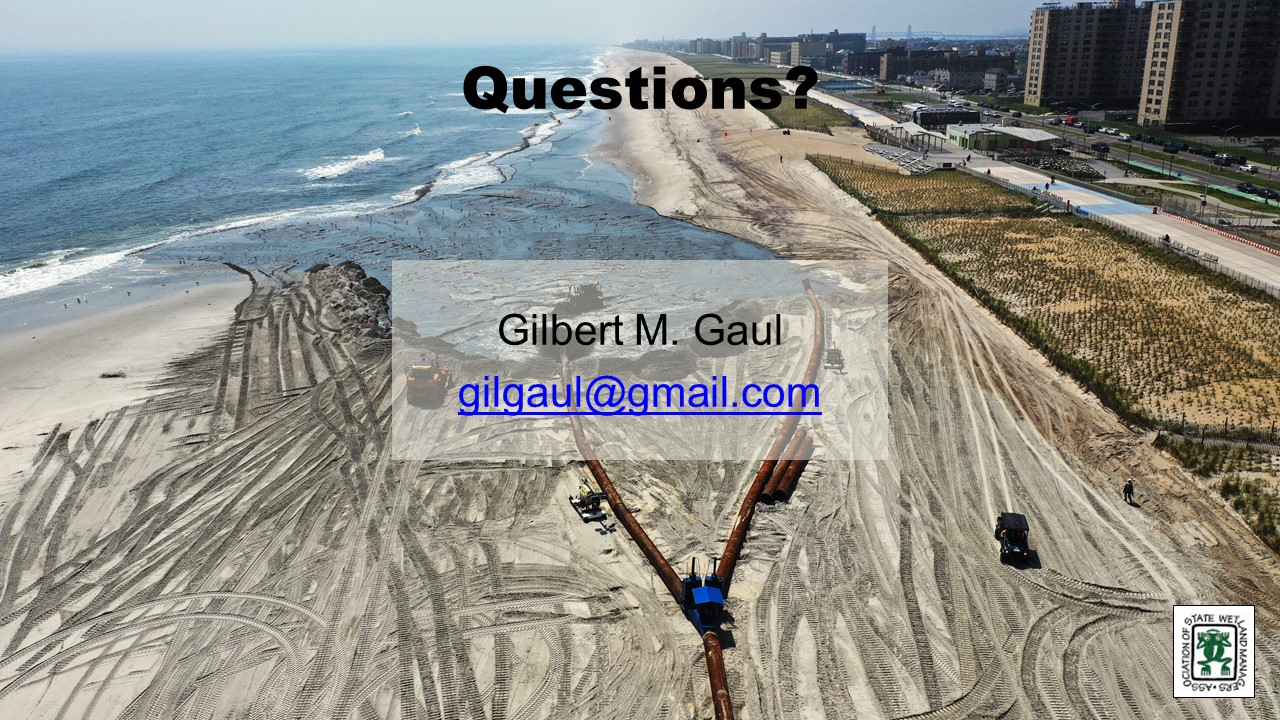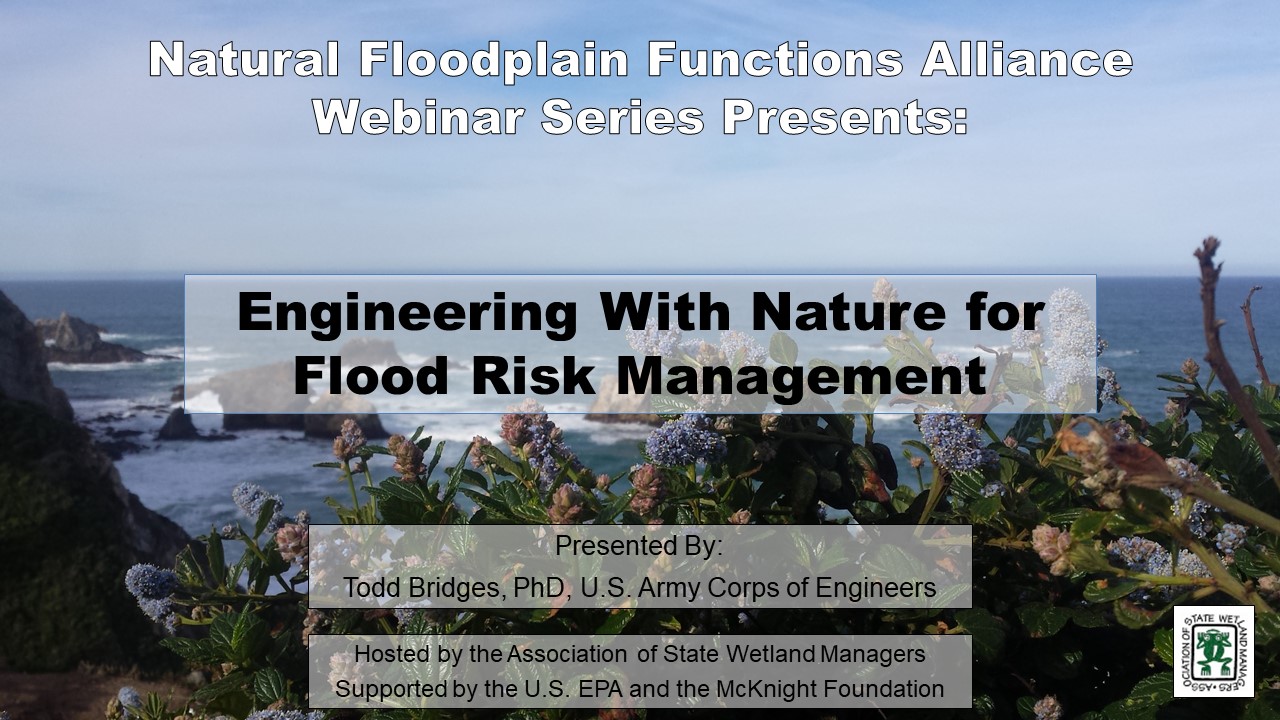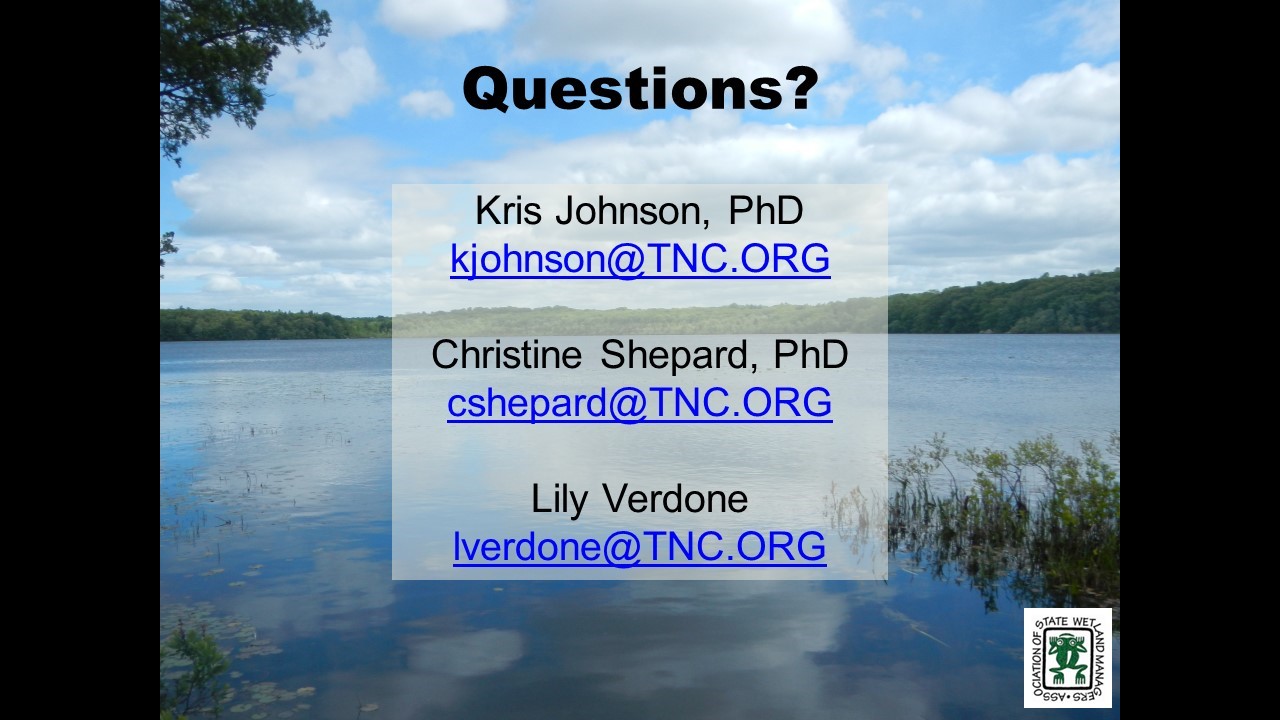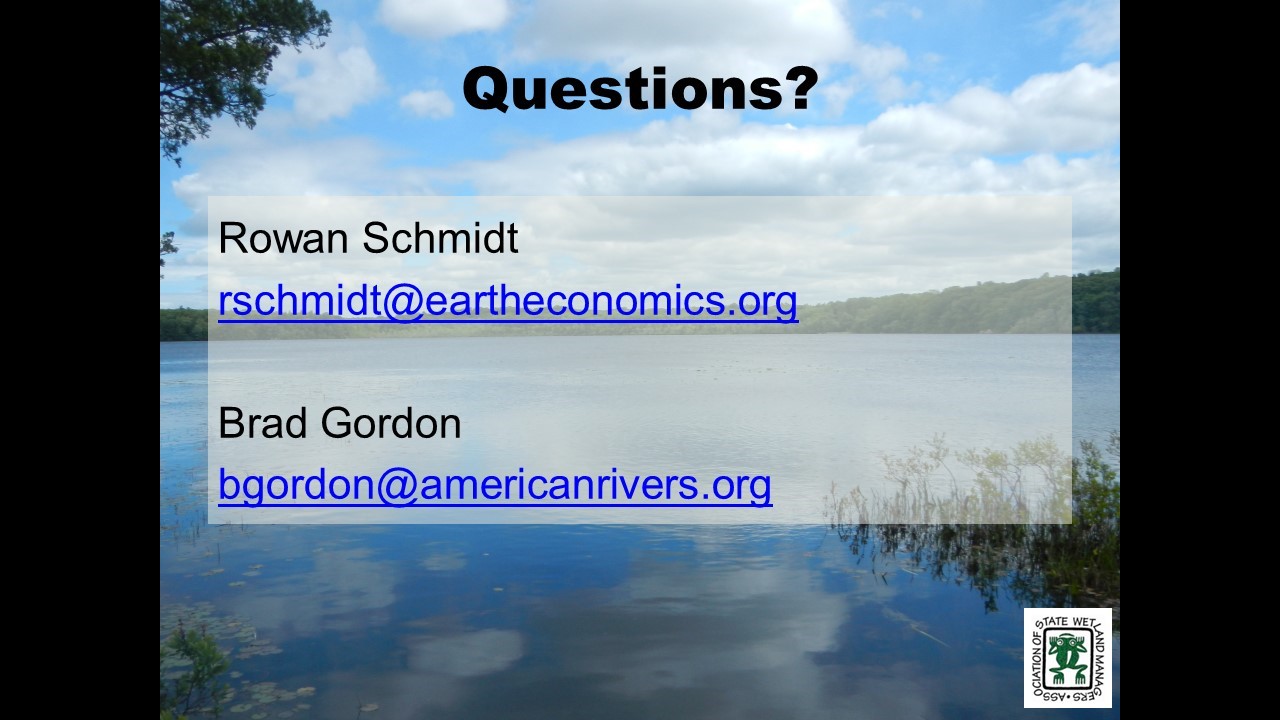National Action Plan to Protect and Restore Floodplains
Held Thursday, February 16, 2023 - 3:00 pm-4:30 pm Eastern
INTRODUCTION AND PRESENTERS
- Eileen Shader, Director, American Rivers
- Marla Stelk, Executive Director, National Association of Wetland Managers
Please click only once on each video recording to view in this window.

Protecting and Restoring Urban Wetlands for Community Benefits
Held Thursday, March 25, 2021 - 3:00 pm-4:30 pm Eastern
INTRODUCTION
- Marla Stelk, Executive Director, Association of State Wetland Managers [PRESENTATION PDF]
PRESENTERS
- William Dooley, Association of State Wetland Managers [PRESENTATION PDF]
- Laurie Gilligan, Colorado Natural Heritage Program [PRESENTATION PDF]
- Jesse Barham, City of Olympia Public Works [PRESENTATION PDF]
ABSTRACT
Wetlands reduce flooding, diminish urban heat, filter water, and provide green spaces for people and wildlife alike making cities more livable. However, state and federal wetland programs often fail to fully recognize and account for the full spectrum of benefits urban wetlands provide. They are often maligned as too small, too ecologically degraded, and facing too many local stressors to be prioritized for restoration and protection by programs with limited available resources. As a result, urban communities are more likely to see their wetland resources developed and impacted while more rural systems are restored and protected. Urban communities' benefit from natural spaces and wetland functions as much as rural areas, even if those natural spaces are not ecologically pristine. Local communities need to take an active role in recognizing, protecting, and restoring their wetland resources. This webinar presented an overview of the needs and challenges surrounding urban wetlands and share examples where communities have taken steps to incorporate wetland resources into broader urban planning and restoration efforts.
Please click only once on each video recording to view in this window.

Disaster Recovery Lessons Learned: Achieving the Best Possible Outcomes for our Communities and Stream Corridors
Tuesday, May 12, 2020 - 3:00pm-4:30pm Eastern
INTRODUCTION
- William Dooley, Policy Analyst, Association of State Wetland Managers [PRESENTATION PDF]
PRESENTERS [PRESENTATION PDF]
- Jeffrey Sickles, Engenuity Engineering Solutions
- Katie Jagt, Watershed Science and Design
- Michael Blazewicz, Round River Design
PRESENTATION DESCRIPTION
This presentation was intended for a wide audience and outlines specific lessons learned during the 2013 Colorado Flood Recovery: some lessons we shared in this are from successes and others are from stumbles, failures, or opportunities that were never realized. The presentation covered highlights of lessons learned from several of the phases and processes involved in recovery including: Organizing for recovery, shared corridors, disaster response, recovery planning, permitting, and pre-disaster planning.
For those interested in reviewing the associated book developed by the presentation team, which goes into more depth on each topic, they can find the document at the link below:
Additional topics covered in the book, but not anticipated to be covered during the presentation, include: the human element, project identification and scoping, design, construction, revegetation, monitoring, and adaptive management.
Please click only once on each video recording to view in this window.

Held Tuesday, March 10, 2020 - 3:00pm-4:30pm
INTRODUCTION
- William Dooley, Policy Analyst, Association of State Wetland Managers [PRESENTATION PDF]
PRESENTER
-
Gilbert M. Gaul, Author [PRESENTATION PDF]
PRESENTATION DESCRIPTION
The last two decades have seen a dramatic increase in losses from hurricanes and floods at the coast – nearly $1 Trillion dollars, with the federal government paying for most of the damage. This talk explored the reasons for the surge in damages and losses, the risks posed by unchecked development on barrier islands, floodplains and wetlands, the likelihood of even larger losses in an age of climate change (warming oceans, sea level rise, bigger & more catastrophic hurricanes and torrential rain bombs), and the ongoing efforts to make coastal communities more resilient.
Please click only once on each video recording to view in this window.
![]()
Focusing on Pre-Event Resilience Building—The Zurich Flood Resilience Alliance Approach
Held Monday, November 18, 2019
Hosted by the Association of State Floodplain Managers
PRESENTER
- Michael Szönyi, MSc, MAS Natural Hazards Management ETH, Flood Resilience Program Lead
Description: In the last five years, a multi-sector alliance of the NGOs sector, academia and Zurich’s risk management experts has focused on shifting from the traditional emphasis on post-event recovery to stress pre-event resilience. More than 110 communities in nine countries have benefited from alliance projects. The evidence-based approach built through dozens of research papers published and implemented in the community programs across the globe illustrates the value of investing in flood resilience.
Flood resilience, however, continues to have trouble gaining wide acceptance and is held back by a lack of investment. According to the ClimateWise Investing for Resilience report, of USD $175 billion economic losses in 2016 that related to natural hazards (of which floods are a major part ) only $50 billion were insured. This $125 billion protection gap is due in part to the lack of evidence of “what works” and because there are few incentives and regulations to encourage investments into sound protection measures at all levels of society. That is why the Alliance’s objectives for the next five-year period will be:
- Supporting the generation of $1 billion in additional funding for flood resilience
- Encouraging effective public policy in support of flood resilience
- Developing sound practices and policy support for flood resilience
- Measurably enhancing flood resilience in vulnerable communities across the world.
“Floods affect more people globally than any other type of natural hazard and cause some of the largest economic, social and humanitarian losses,” said Linda Freiner, Group Head of Sustainability. “By using Zurich’s risk expertise as a global insurer, we can help customers and communities reduce the devastating impacts of floods - even before a flood hits - and build resilience to this disaster. We will work with the alliance members to raise USD $1 billion for investing into building resilience to floods globally – and save lives.”
Alliance members aim to achieve the financial target by rolling out best-practice community programs that will prove the value of resilience-building. The alliance members will share knowledge about the existing and future achievements to encourage various stakeholders to invest in resilience.
Please click only once on each video recording to view in this window.
![]()
Engineering with Nature for Flood Risk Management
Held Tuesday, October 15, 2019 - 3:00 p.m. Eastern
INTRODUCTION
- William Dooley, Policy Analyst, Association of State Wetland Managers [PRESENTATION PDF]
PRESENTER
- Todd Bridges, PhD, U.S. Army Corps of Engineers [PRESENTATION PDF]
ABSTRACT
The webinar provided an update on the USACE Engineering with Nature® initiative, including the recent publication of the book “Engineering With Nature: an Atlas” that includes descriptions of 56 projects around the world. The growing international interest in leveraging natural systems and processes to support engineering functions, while also producing environmental and social value, is reflected in a number of projects, programs, and initiatives around the world, which will be used to highlight the lessons being learned as well as needs and opportunities for the future.
Please click only once on each video recording to view in this window.
Reducing Flood Risk and Restoring Ecosystems through Science and Planning
Held Tuesday, June 4, 2019
INTRODUCTION
- William Dooley, Policy Analyst, Association of State Wetland Managers, Marla Stelk, Executive Director, Association of State Wetland Managers [PRESENTATION PDF]
PRESENTERS
- Kris Johnson, PhD, Associate Director for Science & Planning, North America Agriculture Program, The Nature Conservancy [PRESENTATION PDF]
- Christine Shepard, PhD, Director of Science, Gulf of Mexico Program, The Nature Conservancy [PRESENTATION PDF]
- Lily Verdone, Director of Freshwater and Marine, The Nature Conservancy [PRESENTATION PDF]
ABSTRACTS
Kris Johnson, PhD
Science & decision tools to guide floodplain protection and restoration in the Mississippi Basin
A majority of the floodplains in the Mississippi River Basin have been converted from natural ecosystems to agriculture or development and are hydrologically disconnected and degraded. Protecting and restoring floodplains is critical to reducing flood impacts to people and property, improving water quality, enhancing wildlife habitat and providing other valuable benefits. Although more funding and capacity are needed to increase the scale and pace of restoration, floodplain management decisions can be informed by a new online tool developed by The Nature Conservancy to help prioritize important areas for floodplain conservation and restoration projects.
Christine Shepard, PhD and Lily Verdone
Strategic Property Buyouts to Enhance Flood Resilience: Creating a Model for Flood Risk Reduction, Community Protection, and Environmental Gains
Using post-Hurricane Harvey damage assessments for Harris County, Texas, we created a strategic approach to voluntary property buyouts that prioritizes clustering buyout properties considering their proximity to open spaces as well as additional environmental and social benefits. Our results show that prioritizing buyouts is cost effective and creates green spaces that add multiple values. This study provides a roadmap for buyout selection that can enhance open space, reduce flood risk, and create more natural amenities for residents to enjoy. In Houston and across coastal and flood-impacted regions nationwide, it can help leaders develop strategic buyout programs that create safer, more resilient communities.
Please click only once on each video recording to view in this window.
Floodplains and Green Infrastructure as Tools for Hazard Mitigation: Barriers and Funding Opportunities
Held Tuesday, May 14, 2019
INTRODUCTION
- William Dooley, Policy Analyst, Association of State Wetland Managers, Marla Stelk, Executive Director, Association of State Wetland Managers [PRESENTATION PDF]
PRESENTERS
- Brad Gordon, Lapham Fellow at American Rivers [PRESENTATION PDF]
- Rowan Schmidt, Program Director, Earth Economics [PRESENTATION PDF]
ABSTRACTS
Brad Gordon
Policy Barriers and Solutions for Restoring Row Crops to Floodplains
American Rivers has been working with partners to restore more floodplains in the Upper Mississippi River Basin. Most of our current projects are targeting repetitively flooded cropland to restore to natural floodplains. Through these projects, we have discovered some barriers that, if addressed, could lead to more restoration projects in the basin. Some current efforts include directing nutrient pollution reduction funds toward floodplain restoration, providing economic analyses for farmers in the floodplain, and fast-tracking disaster relief to floodplain easements. While the barriers are becoming clearer, we still need to connect the dots between more on-the-ground needs and solutions.
Rowan Schmidt
Leveraging FEMA Funding for Nature-Based Solutions to Support Hazard Mitigation
Natural disasters such as floods, wildfires, and droughts are increasing in frequency and severity in the US. FEMA has begun to recognize and emphasize the value of investing in the conservation and stewardship of healthy landscapes for mitigating the impacts of floods, wildfires, and droughts, as reflected by recent policy updates in 2013 and 2016, and is also placing a greater emphasis on proactive investments before disasters occur (PDM). Earth Economics supported FEMA on the economics behind their 2013 and 2016 policies and has been supporting partners in CA (post-wildfire), TX (post-Harvey) and other states to navigate these opportunities, conduct benefit-cost analysis, and apply for HMPG funding for projects that have overlapping conservation and hazard mitigation benefits.
Please click only once on each video recording to view in this window.
View Past Natural Floodplain Functions Alliance Webinars
PDF List of Past Natural Floodplain Functions Alliance Webinar Recordings

